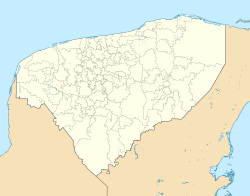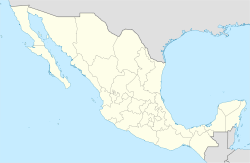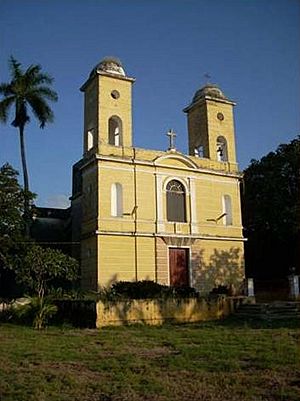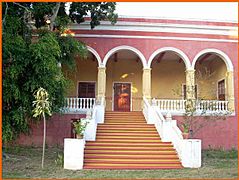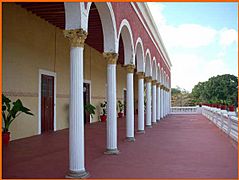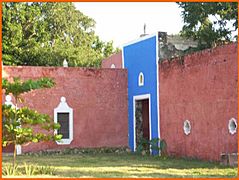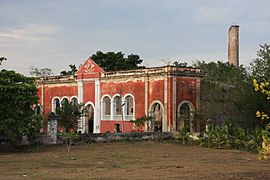San José Chactún facts for kids
Quick facts for kids
San José Chactún
|
|
|---|---|
|
Hacienda
|
|
 |
|
| Motto(s):
Piedra Roja (Red Stone)
|
|
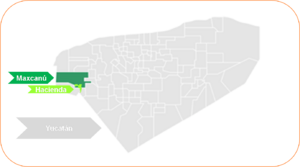 |
|
| Country | |
| State | |
| Municipality | Maxcanú Municipality |
| Founded | 1560 |
| Elevation | 13 m (43 ft) |
| Demonym(s) | Chactuneño |
| Time zone | Central Standard Time |
| • Summer (DST) | Central Daylight Time |
| Area code(s) | (52) 997 |
| Major Airport | Merida (Manuel Crescencio Rejón) International Airport |
| IATA Code | MID |
| ICAO Code | MMMD |
The Hacienda San José Chactún is a historic estate located in the Yucatán State of Mexico. A hacienda is like a large farm or ranch with a main house and other buildings. It was once a very important place for farming and trade.
Contents
Exploring the Hacienda's Location
This hacienda is special because it has many old historical items. It also has large areas of untouched nature. You can find lots of different plants and animals here.
It is very close to famous ancient sites. These include Uxmal and Oxkintok, which are Mayan ruins. The Puuc route, a path connecting several Mayan sites, is also nearby. You can explore caves like Calcehtok and Loltún.
The hacienda is also close to beautiful colonial cities. These are Merida and Campeche. Both are known for their old buildings and history. You can also visit the coastal area of Celestún. This area is a special place for wildlife. And of course, the famous Chichen Itza site is not far away.
Ancient History of Chactún
The first city here was built by the Toltec people. Their ancient remains are over 2,800 years old. The first Mayan groups settled here later. This was during the late Classical period.
The area is part of the Mayan region called "Puuc". The people here connected their towns with special white roads. These roads were called "sacbé". They were used for religious ceremonies. The name "Chactún" means "Red Rock" or "red stone". This is because of the natural color of the stone used in their buildings.
Some parts of the ancient Toltec city are now in a museum. You can find them in the National Archaeological Museum of Spain. A man named Don Jose Dominguez, who owned the hacienda, gave them away in 1865.
In 1995, experts talked about Chactún. They said it was one of the first important Mayan places. It developed its unique buildings and city style around 300 BCE. Other early Mayan cities include Mirador and Tikal.
In 1876, Dr. Augustus Le Plogeon visited Yucatán. He wrote about his discoveries. He mentioned the Hacienda Chactún in his book. He described a large ruin there. It looked like a building at Uxmal called the 'House of the Nuns'. This building had rooms around a central courtyard. Some rooms were used to store corn.
The Story of Hacienda Chactún
Haciendas in Yucatán were like big estates. They were started by the Spanish in the 1500s. They were similar to the feudal system in Europe. At first, they grew corn. Later, they also produced cane sugar, henequen (a plant fiber), and raised cattle.
San Jose Chactún became a very important hacienda. This was during a time when Yucatán was doing very well. It had a train station and many services for its workers. The hacienda worked like a small town. It has two churches. There is a main house and another house called "Raya's House". You can also see the ruins of the old canteen, the sugar mill, and the stables. There is also a huge building for machines.
The first official papers for the land date back to January 9, 1560. The land was greatly improved between 1623 and 1700. In 1700, a part of the land was sold. This made the property become "Hacienda Chactún Nohcacab". Its borders were near the towns of Maxcanú, Becal, Calkiní, and Halachó.
In the late 1700s, a Spaniard named Pedro Tadeo bought the property. This information comes from old documents.
In the early 1800s, the estate belonged to Lorenzo Peon y Cano. Later, his granddaughter, Maria de Jesus Peon Fajardo, inherited it. Her son, José Dominguez Peón, then owned it.
For a long time, the hacienda stayed with the same family. They also owned the Montejo palace in Merida. José Dominguez Peón was a part-owner of the Merida-Campeche railroad. He made sure that one of the 8 train stops was at his hacienda. This train line opened in 1898.
The hacienda continued to produce henequen until about 60 years ago. After that, it slowly lost its importance. Then, Sara Arrigunaga Juanes started a project. She began fixing up the buildings. She also tried to increase its production by raising cattle and growing citrus fruits.
The special saints of the hacienda are Saint Joseph (celebrated on March 19) and Our Lady of the Immaculate Conception (celebrated on December 8).
Images for kids
See also
 In Spanish: Hacienda San José Chactún para niños
In Spanish: Hacienda San José Chactún para niños


